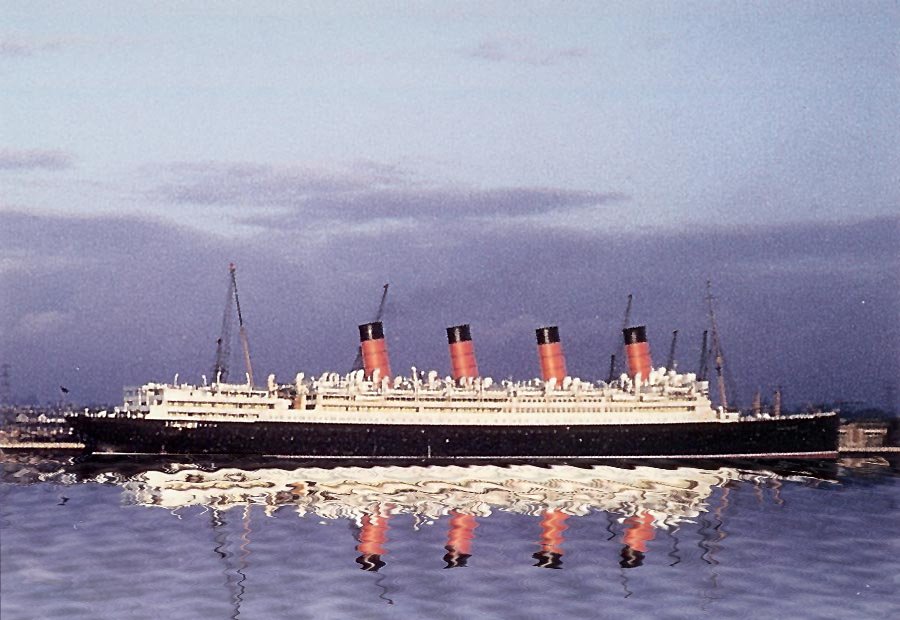|
Aquitania is thought to have been the most
beautiful of all the four-stackers. In fact, she even earned
herself the nickname as the "Ship
Beautiful". Even today, her name brings the image of
the illustrious pre-World War I floating palaces. She was long
and slender, and had four funnels, which all worked, which means that
they were all used to disperse smoke and exhausts, instead of any
number of them being ventilators. Furthermore, she had a
pleasing counter stern.
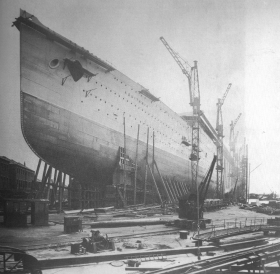 Like
many other famous Cunard liners, Aquitania was ordered from the
John Brown and Company yards of Clydebank, Scotland. Her designs
were under strict Admiralty supervision, because even though World War
I was still a number of years off, the idea that the Aquitania
would be able to be converted for military use as an armed merchant
cruiser had high marks with the admiralty. Otherwise, the plans
called for her to be a well-decorated third partner to Lusitania
and Mauretania. However, there was no intention for Aquitania
to be a contender for the Blue Riband, but she was by no means a slow
ship. Like
many other famous Cunard liners, Aquitania was ordered from the
John Brown and Company yards of Clydebank, Scotland. Her designs
were under strict Admiralty supervision, because even though World War
I was still a number of years off, the idea that the Aquitania
would be able to be converted for military use as an armed merchant
cruiser had high marks with the admiralty. Otherwise, the plans
called for her to be a well-decorated third partner to Lusitania
and Mauretania. However, there was no intention for Aquitania
to be a contender for the Blue Riband, but she was by no means a slow
ship.
On April 21, 1913, Aquitania was launched.
In May 1914, she went on her trials, and made a full knot over what
she was expected to do. However, her commercial service was
brief. In August 1914, she was seized by the British government
for use as an armed merchant cruiser. However, after a serious
collision, it was determined that large ships were too risky in that
role, and were better suited as hospital ships and troop ships with
military escorts.
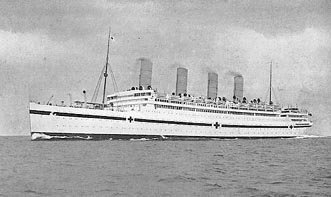 Consequently
in the spring of 1915, she was converted into a trooper, and made
voyages to the Dardanelles, and then was converted into a hospital
ship. However, in 1916, she was returned to the trooping front,
and then in 1917, she was laid up. In 1918, she was back on the
high seas in more military service, and then in June 1919, she ran a
Cunard "austerity service" between Southampton and New York. Consequently
in the spring of 1915, she was converted into a trooper, and made
voyages to the Dardanelles, and then was converted into a hospital
ship. However, in 1916, she was returned to the trooping front,
and then in 1917, she was laid up. In 1918, she was back on the
high seas in more military service, and then in June 1919, she ran a
Cunard "austerity service" between Southampton and New York.
In December 1919, the Aquitania docked at the
Armstrong Whitworth yards in Newcastle in order to be refitted for
post-war service. The major change was that she was converted
from coal to oil-burning. Other than that, all her original
fittings and art pieces 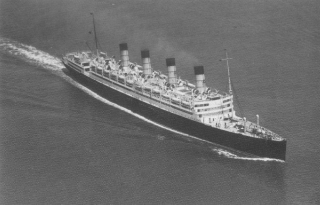 were
brought out of storage and reinstalled. Sadly, though, as she
was being refitted, an engine room explosion killed one of her crew
members. were
brought out of storage and reinstalled. Sadly, though, as she
was being refitted, an engine room explosion killed one of her crew
members.
When she returned to transatlantic service, she
ended up becoming the most popular liner on the North Atlantic for the
next two decades. She was not only favored with those in
Hollywood, but also royalty, government officials, investors, great
athletes, and more. Furthermore, she appealed to travelers that
did not favor any particular liner. During this time, her
running mates were the Blue Riband holder Mauretania, and the
Cunard flagship Berengaria. She was refitted in 1926.
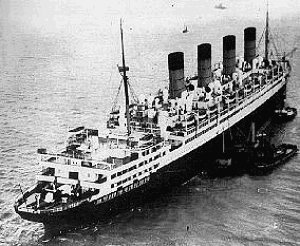 During
the Great Depression, she was sent periodically on cruises to the
Mediterranean, particularly in the Depression's early years. She
also made on troop voyage to Palestine during this time. In
1933, she was once again refitted, with a sound theater being one of
the new additions. She also ran aground twice in these years.
The first time was on Calshot Spit, and she was refloated in two and a
half hours. The second was off Southampton when returning from a
Mediterranean cruise during 60 mph winds, which kept her in place for
twenty-six hours. During
the Great Depression, she was sent periodically on cruises to the
Mediterranean, particularly in the Depression's early years. She
also made on troop voyage to Palestine during this time. In
1933, she was once again refitted, with a sound theater being one of
the new additions. She also ran aground twice in these years.
The first time was on Calshot Spit, and she was refloated in two and a
half hours. The second was off Southampton when returning from a
Mediterranean cruise during 60 mph winds, which kept her in place for
twenty-six hours.
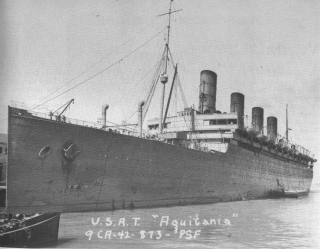 In
1936, she was paired with the Queen Mary. The plan was to
keep her in service until 1940, when she would be replaced with the Queen
Elizabeth. Cunard planned to have the Aquitania
scrapped at this point. However, this was not to be the case.
World War II broke out, and Aquitania was converted into a
troopship again. She now had accommodation for 7,724 soldiers. In
1936, she was paired with the Queen Mary. The plan was to
keep her in service until 1940, when she would be replaced with the Queen
Elizabeth. Cunard planned to have the Aquitania
scrapped at this point. However, this was not to be the case.
World War II broke out, and Aquitania was converted into a
troopship again. She now had accommodation for 7,724 soldiers.
Her service in World War II was no less
distinguished than her service in World War I. In her eight
years of further military work, she sailed more than 500,000 miles,
and carried 300,000 soldiers, to such places as Australia, the South
Pacific, and the Indian Ocean. She was the only pre-1914 liner
to survive this duty.
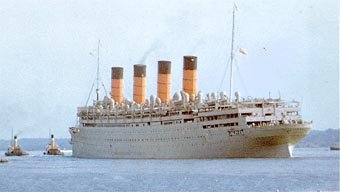 In
1946-1948, she carried war brides, and was then returned to Cunard.
She was hastily refitted and painted in Cunard colors, and then made
an "austerity service" between Southampton and Halifax, for
immigrants, displaced people, and the last remaining troops. She
made twelve voyages of this nature in 1948, and thirteen in 1949.
She may have very well continued on for even longer, but mechanical
and structural problems began to appear. As a result, she was
not given an operating certificate beyond 1949. So on December
1, 1949, she reached Southampton after her 443rd voyage and 35 years
of service. She also marked the end of an era as the last
of the four-stacked liners. In
1946-1948, she carried war brides, and was then returned to Cunard.
She was hastily refitted and painted in Cunard colors, and then made
an "austerity service" between Southampton and Halifax, for
immigrants, displaced people, and the last remaining troops. She
made twelve voyages of this nature in 1948, and thirteen in 1949.
She may have very well continued on for even longer, but mechanical
and structural problems began to appear. As a result, she was
not given an operating certificate beyond 1949. So on December
1, 1949, she reached Southampton after her 443rd voyage and 35 years
of service. She also marked the end of an era as the last
of the four-stacked liners.
She was sold to BISCO, Ltd., and reached Faslane,
Scotland on February 21, 1950. In Faslane, she was scrapped.
|


![]()
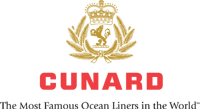
![]()
